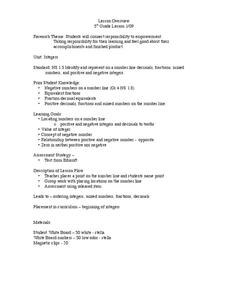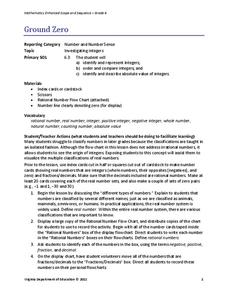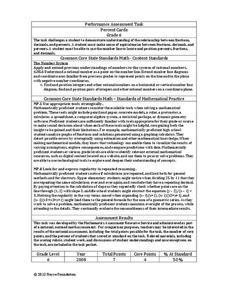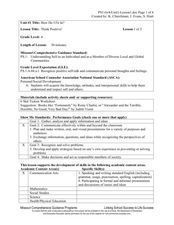Curated OER
Understanding Subtraction- True or False?
In this understanding subtraction worksheet, students read 14 subtraction statements before labeling each as being true or false. They work with both positive and negative numbers.
California Education Partners
Least and Greatest
Squares can be magic. Pupils use their knowledge of addition of positive and negative rational numbers to create a 3 X 3 magic square where the sums are 1. Scholars create addition and multiplication expressions with a set of rational...
Curated OER
Integers Homework #1
In this simple worksheet, learners add and subtract positive and negative integers. Mathematicians plot the problem on a number line beside each of the 24 problems. You might want to white out the answers at the bottom of each page and...
EngageNY
Mid-Module Assessment Task: Grade 7 Module 2
A seven-question assessment determines how well your learners understand the procedures to add, subtract, multiply, and divide signed rational numbers. Pupils show their understanding through problem-solving situations.
EngageNY
Extending the Domain of Sine and Cosine to All Real Numbers
Round and round we go! Pupils use reference angles to evaluate common sine and cosine values of angles greater than 360 degrees. Once they have mastered the reference angle, learners repeat the process with negative angles.
Curated OER
Multiplication and Division of Real Numbers
In this multiplication and division worksheet, students multiply and divide positive and negative fractions, decimals, and whole numbers. This two-page worksheet contains 72 problems.
Curated OER
Integers
Using a simple technique, learners practice identifying integers on a number line. As numbers, both positive and negative, are pointed to, they name them. This could be part of anticipatory set before a lesson on integers.
Curated OER
Unlocking the Secrets of Math: Simple Steps to Becoming a Better Mathematician
Help your students remember math tricks and rules. Review working with positive and negative numbers, decimals, and the order of operations in this engaging presentation.
Curated OER
Multiplying integers
In this multiplying integers worksheet, students complete multiplication problems of positive and negative numbers. Students complete 80 problems and 16 review problems.
Curated OER
Ordering Integers
Sixth and seventh graders compare and order integers. After locating integers in a newspaper, they describe examples of negative and positive integers. They draw a thermometer and locate positive and negative integers on the scale. In...
Pennsylvania Department of Education
Fractional Parts Using an Area Model
Learners explore multiplying fractions and their relationship to parts of a whole. They draw and shade fractional parts to show parts of a whole and fractional parts of a fraction. Pupils also use an Internet site for interactive practice.
Curated OER
What Is A Number?
Seventh graders engage in a lesson that is focused upon teaching the concept of integer numbers with a focus upon the integers. They practice solving different problems using positive and negative numbers. They then attempt to describe...
Curated OER
My Test Book: Rational and Irrational Numbers
In this online interactive math skills worksheet, students solve 10 multiple choice math problems regarding rational and irrational numbers. Students may submit their answers to be scored.
Virginia Department of Education
Ground Zero
Don't harbor any negative feelings toward negative numbers. Scholars learn about different classifications of rational numbers, including negative integers. They also develop definitions of the opposite and the absolute value of a...
Curated OER
Adding and Subtracting Integers
Middle schoolers use discs in order to add and subtract integers. There are manipulatives present so kinesthetic learners can access the curriculum. They also review the concept of the opposite of positive and negative numbers.
Charleston School District
Evaluation of Roots
You mean the square root of five and five don't have the same value? Learners estimate the value of irrational roots. As they practice estimating the value, they increase their understanding of roots. The lesson is the fourth in a series...
Noyce Foundation
Percent Cards
Explore different representations of numbers. Scholars convert between fractions, decimals, and percents, and then use these conversions to plot the values on a horizontal number line.
University of the Desert
Why Is Cultural Diversity a Positive Thing?
From more empathetic individuals to greater tolerance in government, learners explore the benefits of a culturally diverse world through a series of collaborative, discussion-based activities.
Curated OER
Comparing and Ordering Positive and Negative Fractions
The comparison and ordering of positive and negative fractions is the focus of this math lesson. Sixth graders are given one card each that has a fraction written on it, and they must put themselves into the proper order in a "human...
Curated OER
Comparing Negative Fractions, Mixed Numbers and Decimal
Seventh graders explore the concept of negative rational numbers. For this negative rational numbers lesson, 7th graders discuss similarities between positive and negative rational numbers. Students predict what rational numbers lie...
Curated OER
Adding and Subtracting Positive and Negative Numbers
In this math worksheet, students complete 32 addition and subtraction problems. The first 22 involve integers. There are 6 problems with positive and negative decimals. The last 4 problems are fractions.
Curated OER
Multiplying integers
In this multiplying integers worksheet, students multiply positive and negative one and two digit numbers. Students complete 30 problems.
Curated OER
Think Positive!
Fourth graders are read a story in which they identify the positive and negative thinking. In groups, they are given a scenerio in which they change the negatives into a positive. They perform the scenerio to tthe class and discuss how...
Curated OER
Rational Numbers
In this rational numbers worksheet, 9th graders solve and complete 12 different problems by dividing each equation. First, they use the division rules given at the top of the sheet to determine how they are going to solve each problems....

























